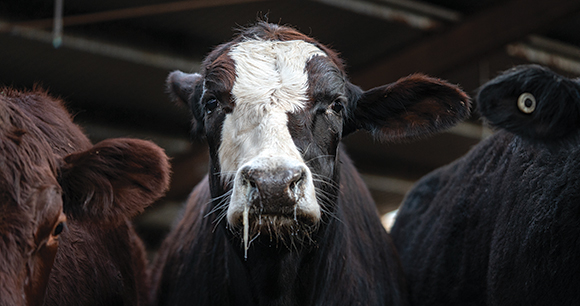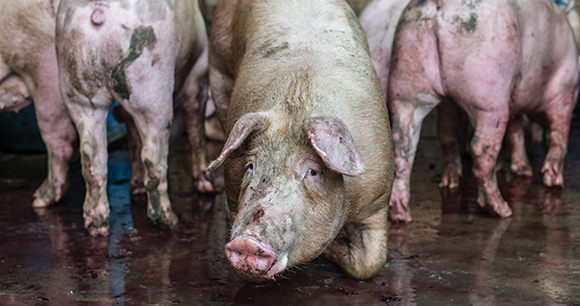Scientists and philosophers call it the “meat paradox”—a type of cognitive dissonance that can occur among people who want to eat meat but not kill animals. The unfortunate reality, however, is that every meat and poultry product on grocery store shelves comes from a sentient individual who was slaughtered for food—nearly 10 billion of them each year in the United States alone.

In modern society, the dissonance is somewhat dampened by the fact that the vast majority of these animals are raised and killed far from the public eye. In the 1950s, however, in response to growing awareness of unchecked cruelty occurring at US slaughterhouses, Congress passed the Humane Methods of Slaughter Act (HMSA) to curtail the abuse and suffering livestock experience at slaughter.
A new AWI report, titled Humane Slaughter Update: Federal and State Oversight of the Welfare of Livestock at Slaughter, examines how effectively the HMSA is being applied to accomplish that aim. (One glaring problem is that the US Department of Agriculture interprets the term “livestock”—the animals covered under the HMSA—to mean cattle, pigs, sheep, and goats, but not birds—the latter of whom constitute roughly 98 percent of the animals slaughtered.)
The report, which builds on previous, similar AWI reports, analyzes federal and state slaughter plant inspection records for the years 2019 through 2022 and makes recommendations about how livestock slaughter and handling practices can be (dramatically) improved. It emphasizes the need for stronger, more rigorously enforced federal and state regulations to address a wide variety of animal abuses that frequently occur in slaughterhouses. These include failing to provide water and feed for animals waiting to be killed; failing to adequately maintain pens, grounds, and equipment; mistreating disabled animals; using excessive force to herd animals; failing to properly stun animals on the first (or even the second, third, or fourth) attempt; and (consequently) shackling, hoisting, and cutting animals who are still conscious.
As noted in the report, mistreatment is especially rampant in certain plants. Within the span of a single year, for example, the USDA suspended or threatened to suspend operations at least three times at nine separate slaughter plants for egregious humane slaughter violations. Such repeat offenders are a long-running problem: The same number of plants were issued multiple suspension notices within a single year during the time span covered by our previous humane slaughter report (2016–2018).
The report also discusses a host of problems associated with slaughter plants that kill and process animals for personal, noncommercial use. Such “custom exempt” facilities are essentially excused from regular federal or state inspection. Inspectors might only observe custom plant operations once or twice per year—and this inspection may not even take place on a day when slaughter activities are occurring. In fact, years may go by without a custom plant’s slaughter operations being observed for compliance with humane handling and slaughter requirements.
Another issue is the USDA’s failure to report instances of egregious abuse at slaughterhouses to local law enforcement officials for potential prosecution under state anticruelty laws. During one year-and-a-half stretch, for example, federal inspectors documented 122 instances of very young calves found dead in transport trucks arriving from California to a slaughter plant in Idaho. About 4,000 calves died in total, with per-truck losses ranging from 5 percent to nearly 30 percent. Yet the records offer no evidence that the USDA initiated an investigation, attempted to contact the trucking company or supplier, or notified local law enforcement.
In another example, over the course of about two years, USDA personnel at a slaughter plant in Iowa documented nearly 250 incidents of excessive use of electrical prods, paddles, pokers, and other animal handling implements affecting tens of thousands of animals. While the USDA did report the situation to the Iowa state veterinarian, there is no evidence that either the department or the veterinarian notified local law enforcement about the potentially criminal mistreatment.

AWI offers a number of recommendations in the report. To reduce the most common types of humane handling violations, we urge the USDA to revise the HMSA’s regulations, including by requiring that all stunning devices be routinely tested, that workers be formally trained in humane handling and slaughter, and that functional backup stunning devices be available. To deal with repeat offenders and discourage future offenses, we call on the department to establish a policy of escalating penalties, including longer suspension periods and more frequent withdrawals of inspection (effectively shutting down a facility). The report also reiterates the numerous recommendations put forward in a petition AWI submitted to the USDA in 2023 to reform custom slaughter regulation, such as requiring that annual or biannual inspections occur only on days when slaughter is taking place, and that the department clarify that custom operations must still adhere to federal humane slaughter and handling requirements. (See AWI Quarterly, spring 2023.)
As a further means of deterring humane slaughter violations, AWI recommends that the USDA and state departments of agriculture cooperate with state and local law enforcement agencies in pursuing criminal animal cruelty charges for incidents of willful animal abuse. This process should begin with the USDA granting a 2023 petition submitted by the nonprofit Animal Partisan, with AWI support, asking the department to clarify law enforcement officials’ authority to enforce state anticruelty statutes. (See AWI Quarterly, fall 2024.)
Meat and poultry companies are well aware of the meat paradox and work hard to ensure that consumers’ taste for animal products is not derailed by their distaste for the killing—and the suffering inherent in producing these products at volume in industrial settings. Keeping the slaughter process hidden from public view is key to this effort. The USDA’s inspection records, however, offer a rare and important window into such operations.
In this report, AWI analyzes the evidence from these records and provides practical steps that should be taken to address the myriad problems associated with animal slaughter in the United States. By bringing this information to light, AWI seeks to increase awareness about the real-world impacts that production practices, policies, and personal food choices have on the welfare of animals and to build support for badly needed reforms.